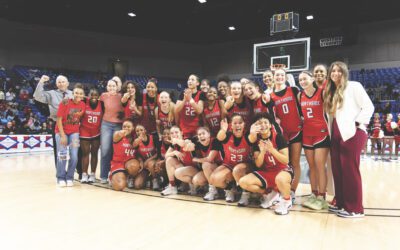[title subtitle=”WORDS Dwain Hebda
IMAGES courtesy Children’s Shelter”][/title]
Haley Morris remembers vividly the knock on the door that changed the course of her life. Though hardly more than a child herself, she’d been essentially on her own since the age of fourteen when, following her father’s death by violence, she turned her back on a tumultuous relationship with her mother and left. She’d seen her siblings parceled off into foster care and was determined to stay one jump ahead of authorities, which she did for the better part of two years.
Then came that knock on the door.
“I was seventeen, a couple months away from being seventeen, actually,” she says. “I had been running from being put in DHS and basically, I was just living by myself at the time, just pretty much on my own. One day, police knocked on the door. I had a warrant, I went to jail and DHS picked me up.”
Haley landed at the Children’s Emergency Shelter in Fort Smith, now the Children’s Shelter. She had all of her emotional armor in place, the kind of interior scales that keep people and the harm they cause at arm’s length.
“I was young. I was pregnant. I didn’t have any resources, any good knowledge,” she said. “I was scared, honestly. I felt like I had been abandoned and I didn’t really know how to react.”
There were more than four thousand of the state’s children in foster care at the end of 2019, per the Arkansas Department of Human Services. Sebastian County is the state’s primary hotspot for such cases; in its eight-county DHS grouping, Sebastian County had roughly one-third more children in foster care than the other seven counties combined (one thousand and eighteen in 2018).
More than that, only one other county in Arkansas had half as many foster kids as Sebastian County did in 2018, with half of those children staying in the system for a period of seven months to two years.
While it should be acknowledged that the number of foster children statewide has decreased in recent years – and with it, the length of time in the system – the chronic issue of children in crisis is what inspired community leaders to create the Children’s Emergency Shelter in 1993.
“In 1993 the Junior League of Fort Smith donated $20,000 and that’s what purchased our lot that we’re on today,” said Ashley Forsgren, Children’s Shelter director of development. “We started construction somewhere around 1995 and we opened our doors November 1, 1997, to five children.”
For the next twenty-two years, the shelter was a forty-five-day haven for kids pulled out of situations of abuse or neglect, giving them a stable roof over their heads and a period of normalcy, however brief. From across the state, children ages six to seventeen continued to attend school, received medical attention as needed, and even went shopping to augment the mere clothes on their back in which many arrived while authorities figured out a more permanent familial or foster placement.
In 2015, the organization expanded to address issues facing kids aging out of the system, most around age eighteen. This totals about two hundred young adults annually in Arkansas, most of whom face a challenging future. Less than three percent earn a college degree, half are unemployed by age twenty-four and seventy-one percent of females are pregnant by age twenty-one. All while lacking a lot of the basic life skills other teens take for granted.
“I grew up watching my parents do things; I saw my mom paying bills on Sundays and I saw my dad sorting clothes for the laundry,” Ashley says. “These kids have never had a consistent human being to watch. They are moved the majority of their life from shelter to shelter, home to home. When they age out, they just want to get the heck out of Dodge. They’ve not learned anything, they’ve not built any social connections, there’s no relationships.
“They end up couch surfing and being offenders just to stay alive and to eat and they repeat the cycle. Seventy percent of youth aging out of foster care end up homeless, hungry, incarcerated or suicidal.”
To help alter these sad statistics, the organization launched GetREAL24, the only program in the state that combines a residential aspect and life skills training into one. The program, which operates without any government funding, runs out of an apartment complex adjacent to the original campus, purchased by Children’s Emergency Shelter Foundation.
“In order to be a part of GetREAL24, a youth had to be in foster care upon their eighteenth birthday,” Ashley says. “They apply for the program and then they’re called in for an interview with our program coordinator along with another shelter representative, a representative from University of Arkansas Fort Smith, and Gamma Rho which is a governing board from within the program participants themselves.”
Once accepted, participants follow a strict set of rules including holding a job, attending school or both; staying sober and clear of legal problems, paying rent and utilities and attending weekly life skills classes where they learn the fundamentals of independent living.
“They’ll build a self-sufficiency plan and that self-sufficiency plan defines what success looks like,” Ashley says. “It’s going to define, sometimes by a day, by a week, when they are expected to graduate out of the program. Those plans are all different and that’s the challenge. Everything has to be very individualized because your needs are different from her needs which are different than mine.”
These individual differences explain the varying pace of change in participants. For every graduate that leaves the program for a stable career there’s another for whom success is learning how to balance a checkbook or master the fundamentals of housekeeping. It’s not always a smooth path but for those like Haley Morris who stick with it, it works.
“This is a place that gives teenagers hope for the future,” she says. “They just pretty much set me on the right path to make sure I had a great career ahead of me. They made me feel like failure wasn’t an option, you know?
“Don’t get me wrong now; me and the staff, we have had our ups and downs, absolutely. They’ve struck fear into my heart on plenty of occasions and I’m so grateful today for that because I took that knowledge and learned from it.”
It would be enough for the organization to focus solely on building the award-winning GetREAL24 program from the nine participants it currently serves, but time and shifting government policy threw another challenge in the organization’s path. Changes in government reimbursement within the foster care structure forced the shelter to reinvent itself as a qualified residential treatment program (QRTP) starting last fall. This changed the group’s name and, if not the overall mission, the way in which the mission is carried out.
“The word ‘emergency’ goes away, our length of stay lengthens to six months to a year per youth and a therapy aspect is added,” Ashley says of the new format. “Adding the therapy aspect was really great because these kids suffer a tremendous amount of behavioral and emotional challenges due to neglect and abuse. Here, they learn how to deescalate with their emotions. They learn how to cope. They learn techniques on growing in a more positive manner behaviorally and emotionally.
“I remind everybody it’s so important to remember these kids are here at no fault of their own. They’re not juvenile delinquents; they’ve done nothing wrong to be removed. They are products of their environment.”
Even with this programmatic shift, government reimbursements only account for a percentage of the funds needed to keep the organization running. One substantial source of funding is an annual gala; this year’s event is entitled Havana Nights and is slated for June. Funds raised will help the organization continue to create success stories such as Haley, for whom the future has never looked more hopeful.
“I have a certified nursing assistant background,” she says proudly. “I’m in a surgical tech program and eventually, I know I’m going to end up in nursing. That’s my career path, that’s my goal, that’s where I see myself. I also work at the Boomerang Diner in Van Buren as well as being a full-time mommy to my little girl.”
The mention of her toddler flashes images through her mind, and she pauses.
“She’s going to know what it is to live a rough life, but she’s not going to have to do it herself, you know?” Haley says. “I made a promise to her the day she was born that she would never have to go through what I went through.”
Children’s Shelter
3015 S 14th St, Fort Smith, Arkansas
479.783.0018
fschildrensshelter.org




